Get free scan and check if your device is infected.
Remove it nowTo use full-featured product, you have to purchase a license for Combo Cleaner. Seven days free trial available. Combo Cleaner is owned and operated by RCS LT, the parent company of PCRisk.com.
What is "Chrome Update Center"?
"Chrome Update Center" is a fake error message displayed on a deceptive website. The message is also known as "Firefox Update Center" and "Internet Explorer Update Center". Its main purpose is to trick people into downloading and installing a Trojan downloader that can cause high-risk computer infections.
Generally, people arrive at this site (or other deceptive/untrustworthy websites) due to potentially unwanted apps (PUAs) that they have installed on their computers or web browsers. Apps of this type usually deliver online ads and collect user-system information.
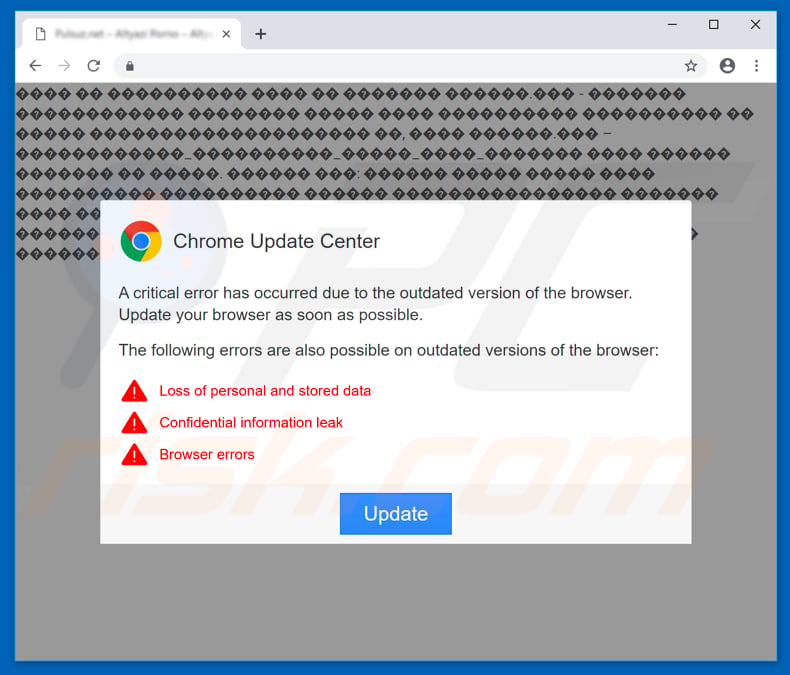
According to the website that displays the "Chrome Update Center" fake error notification, a critical error occurred since the browser is outdated. Visitors are urged to update their browsers by clicking the "Update" button immediately. This fake warning suggests that if the browser is not updated, other problems such as personal data/information loss or other errors might occur.
If clicked, the update button triggers download of a JavaScript (.js) file that, once executed, downloads and installs a Trojan downloader, a program designed to download trojan-type programs. Trojans are usually designed to cause chain infections - once installed, they spread other infections (other Trojans) or ransomware-type programs such as Crypted000007.
Having these programs installed usually results in serious problems relating to data and financial loss, identity theft, privacy issues, and so on.
This fake error message should not be trusted and websites of this type should be closed. If the site cannot be closed in the normal way (by closing the browser tab or window), use Task Manager and ending running browser processes from there.
Apps (PUAs) that cause redirects to deceptive, malicious websites such also feed users with intrusive ads: coupons, banners, surveys, pop-ups, etc. These are annoying and displayed through tools that enable placement of third party graphical content on any site. Therefore, they conceal content of visited websites.
Furthermore, when clicked, they open untrustworthy websites or run scripts that download/install even more PUAs. Bear in mind that these apps often collect browsing-related information such as IP addresses, search queries, URLs of visited websites, geo-locations, and so on.
PUAs also record personal details. Developers share the information with third parties (potentially, cyber criminals) who misuse it to generate revenue. PUAs cause many problems relating to privacy, browsing safety, or even identity theft, and should thus be uninstalled immediately.
| Name | "Chrome Update Center" pop-up |
| Threat Type | Trojan, Password stealing virus, Banking malware, Spyware |
| Symptoms | Trojans are designed to stealthily infiltrate victim's computer and remain silent thus no particular symptoms are clearly visible on an infected machine. |
| Distribution methods | Infected email attachments, malicious online advertisements, social engineering, software cracks. |
| Damage | Stolen banking information, passwords, identity theft, victim's computer added to a botnet. |
| Malware Removal (Windows) |
To eliminate possible malware infections, scan your computer with legitimate antivirus software. Our security researchers recommend using Combo Cleaner. Download Combo CleanerTo use full-featured product, you have to purchase a license for Combo Cleaner. 7 days free trial available. Combo Cleaner is owned and operated by RCS LT, the parent company of PCRisk.com. |
There are many fake notifications (regarding errors, viruses, and so on). Some examples that are similar to "Chrome Update Center" are HoeflerText Font Was Not Found, Microsoft Azure, and Windows Product Key Expired. All are displayed on deceptive, dubious websites. Not all are designed to infect computers with infections.
These websites often trick people into paying for unnecessary software or services. Most PUAs are very similar. They are promoted as useful and legitimate, however, they are designed only to generate revenue for the developers. Their actions often cause users various problems and do not provide any real value.
How did potentially unwanted applications install on my computer?
PUAs are usually promoted and distributed using supposedly official websites, however, most people install them inadvertently. This happens when dubious/deceptive ads are clicked or is due to careless downloads and installations.
To trick people into download/installation of unwanted apps, developers use "bundling" - the hiding of unwanted apps in software download or installation set-ups.
They place these apps in "Custom", "Advanced" and other parts of the set-ups. Information about the inclusion of unwanted apps is not properly disclosed, however, this method works only if people install or download software without checking settings and leave them unchanged.
How to avoid installation of potentially unwanted applications?
Download software using official websites and direct links. Avoid peer-to-Peer networks (torrent clients, eMule, and so on), third party downloaders, unofficial, suspicious websites, and other channels. Handle software installations (or downloads) with patience.
Each installation dialog window (step) should be studied and all available "Custom", "Advanced" and other similar settings checked. Not all ads on the internet are legitimate, especially those displayed on untrustworthy, unofficial websites. Some redirect to untrustworthy websites such as gambling, pornography, adult dating, and so on.
If these ads appear often or redirects happen without even clicking them, check installed extensions, add-ons, and plug-ins on your browser and programs on your computer. Remove/uninstall all unwanted/unknown entries immediately. If your computer is already infected with PUAs, we recommend running a scan with Combo Cleaner Antivirus for Windows to automatically eliminate them.
Text presented in "Chrome Update Center" pop-up:
A critical error has occurred due to the outdated version of the browser. Update your browser as soon as possible.
The following errors are also possible on outdated versions of the browser:
Loss of personal and stored data
Confidential information leak
Browser errors
The appearance of "Chrome Update Center" pop-up (GIF):
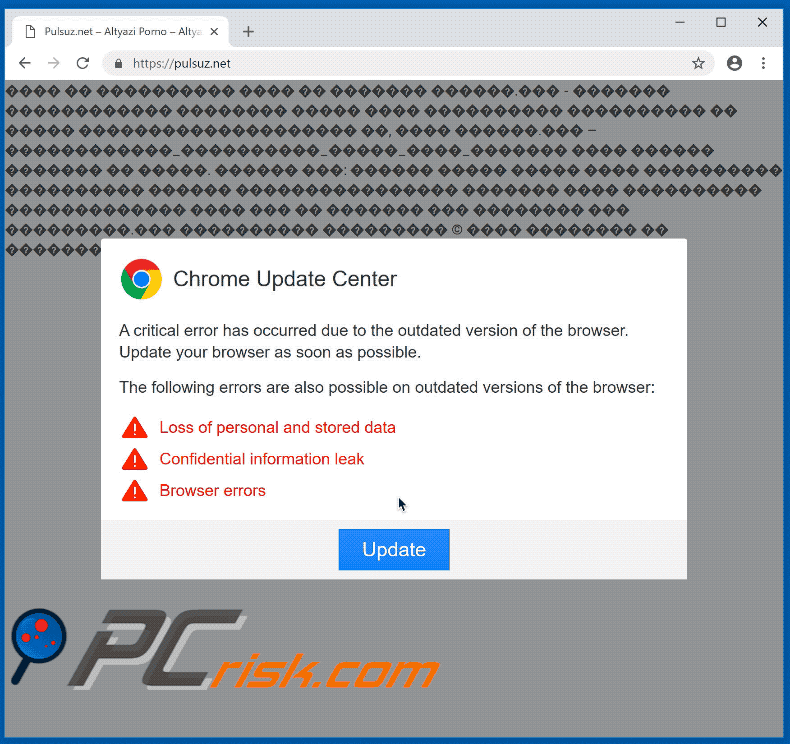
Screenshot of this deceptive website opened using Mozilla Firefox browser:
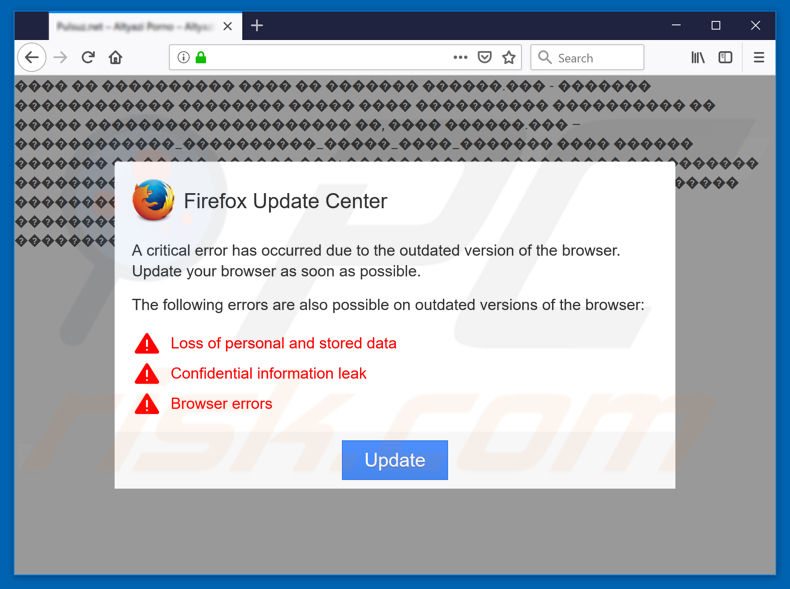
Screenshot of this deceptive website opened using Internet Explorer browser:
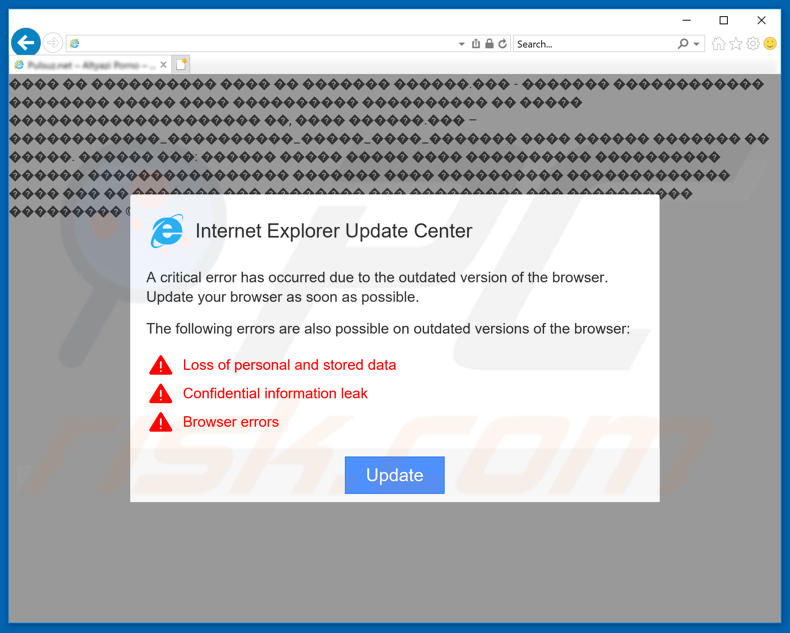
Screenshot of a downloaded JavaScript file designed to install Trojan downloader:
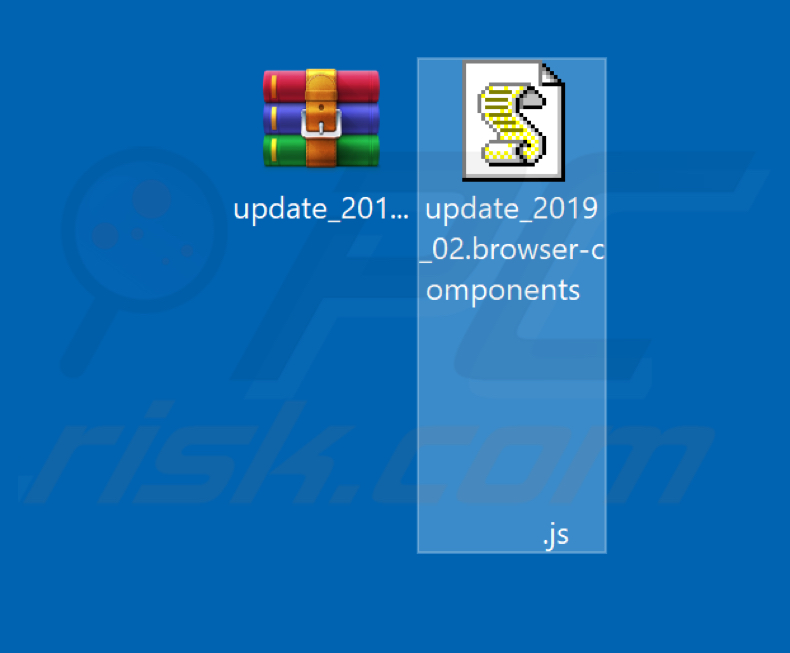
Instant automatic malware removal:
Manual threat removal might be a lengthy and complicated process that requires advanced IT skills. Combo Cleaner is a professional automatic malware removal tool that is recommended to get rid of malware. Download it by clicking the button below:
DOWNLOAD Combo CleanerBy downloading any software listed on this website you agree to our Privacy Policy and Terms of Use. To use full-featured product, you have to purchase a license for Combo Cleaner. 7 days free trial available. Combo Cleaner is owned and operated by RCS LT, the parent company of PCRisk.com.
Quick menu:
- What is "Chrome Update Center"?
- STEP 1. Uninstall deceptive applications using Control Panel.
- STEP 2. Remove adware from Internet Explorer.
- STEP 3. Remove rogue extensions from Google Chrome.
- STEP 4. Remove potentially unwanted plug-ins from Mozilla Firefox.
- STEP 5. Remove rogue extensions from Safari.
- STEP 6. Remove rogue plug-ins from Microsoft Edge.
Removal of potentially unwanted applications:
Windows 11 users:

Right-click on the Start icon, select Apps and Features. In the opened window search for the application you want to uninstall, after locating it, click on the three vertical dots and select Uninstall.
Windows 10 users:

Right-click in the lower left corner of the screen, in the Quick Access Menu select Control Panel. In the opened window choose Programs and Features.
Windows 7 users:

Click Start (Windows Logo at the bottom left corner of your desktop), choose Control Panel. Locate Programs and click Uninstall a program.
macOS (OSX) users:

Click Finder, in the opened screen select Applications. Drag the app from the Applications folder to the Trash (located in your Dock), then right click the Trash icon and select Empty Trash.
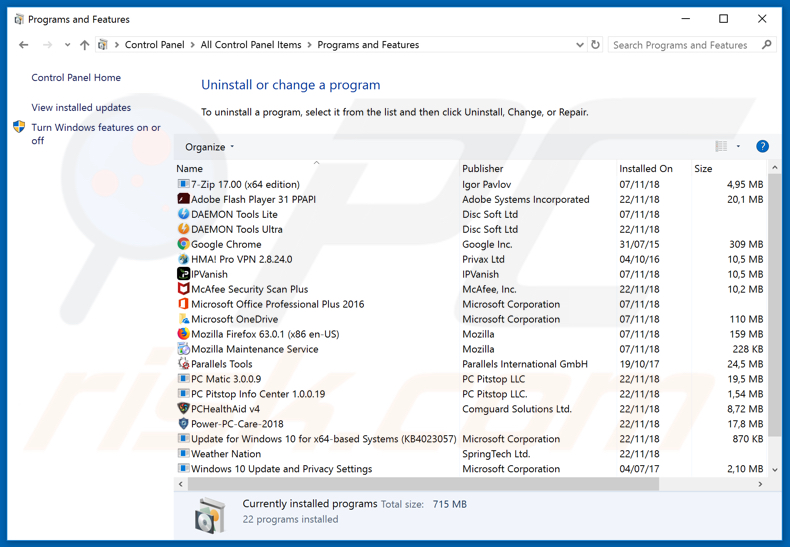
In the uninstall programs window, look for any suspicious/recently-installed applications, select these entries and click "Uninstall" or "Remove".
After uninstalling the potentially unwanted application, scan your computer for any remaining unwanted components or possible malware infections. To scan your computer, use recommended malware removal software.
DOWNLOAD remover for malware infections
Combo Cleaner checks if your computer is infected with malware. To use full-featured product, you have to purchase a license for Combo Cleaner. 7 days free trial available. Combo Cleaner is owned and operated by RCS LT, the parent company of PCRisk.com.
Remove rogue extensions from Internet browsers:
Video showing how to remove potentially unwanted browser add-ons:
 Remove malicious add-ons from Internet Explorer:
Remove malicious add-ons from Internet Explorer:
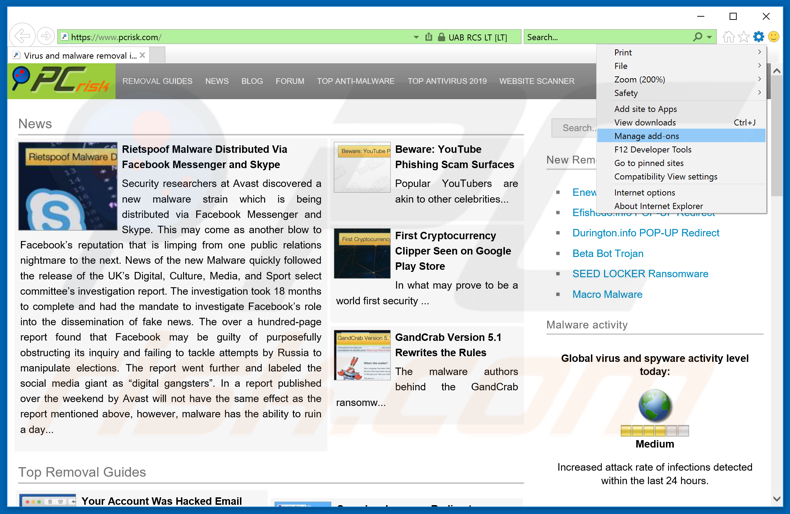
Click the "gear" icon ![]() (at the top right corner of Internet Explorer), select "Manage Add-ons". Look for any recently-installed suspicious browser extensions, select these entries and click "Remove".
(at the top right corner of Internet Explorer), select "Manage Add-ons". Look for any recently-installed suspicious browser extensions, select these entries and click "Remove".
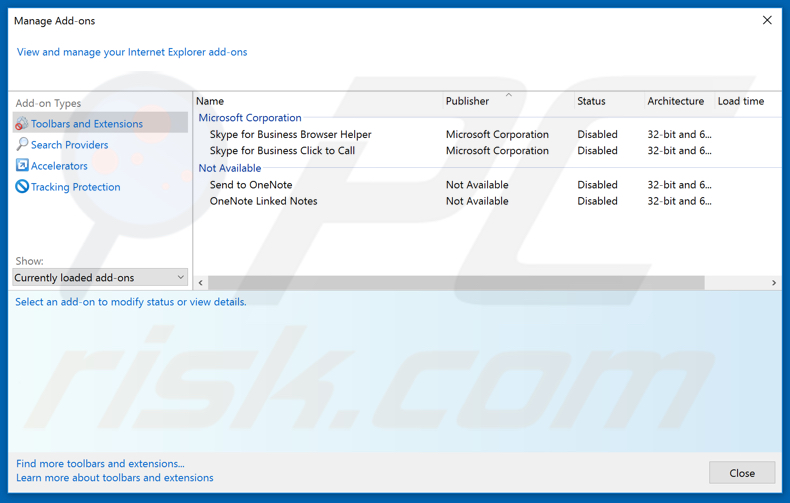
Optional method:
If you continue to have problems with removal of the "chrome update center" pop-up, reset your Internet Explorer settings to default.
Windows XP users: Click Start, click Run, in the opened window type inetcpl.cpl In the opened window click the Advanced tab, then click Reset.

Windows Vista and Windows 7 users: Click the Windows logo, in the start search box type inetcpl.cpl and click enter. In the opened window click the Advanced tab, then click Reset.

Windows 8 users: Open Internet Explorer and click the gear icon. Select Internet Options.

In the opened window, select the Advanced tab.

Click the Reset button.

Confirm that you wish to reset Internet Explorer settings to default by clicking the Reset button.

 Remove malicious extensions from Google Chrome:
Remove malicious extensions from Google Chrome:
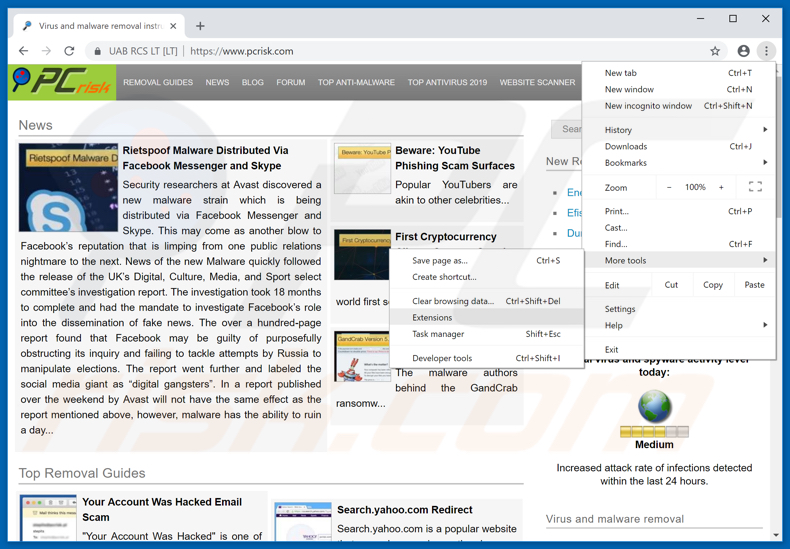
Click the Chrome menu icon ![]() (at the top right corner of Google Chrome), select "More tools" and click "Extensions". Locate all recently-installed suspicious browser add-ons and remove them.
(at the top right corner of Google Chrome), select "More tools" and click "Extensions". Locate all recently-installed suspicious browser add-ons and remove them.
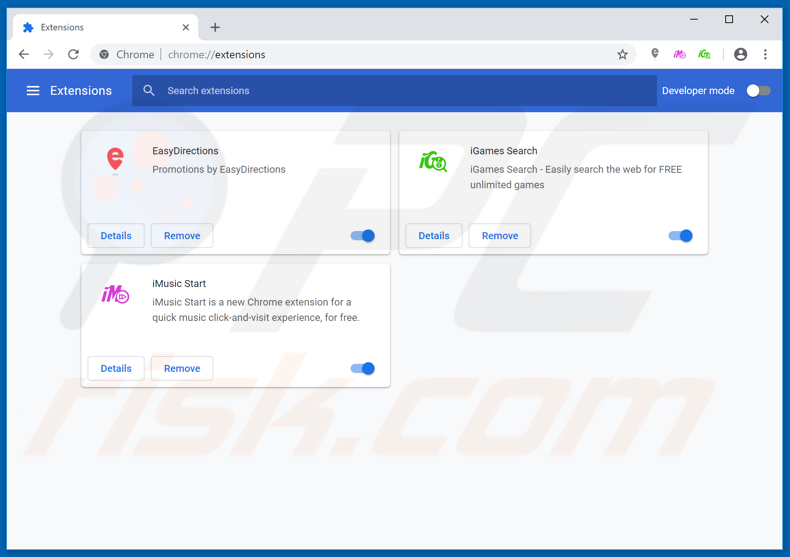
Optional method:
If you continue to have problems with removal of the "chrome update center" pop-up, reset your Google Chrome browser settings. Click the Chrome menu icon ![]() (at the top right corner of Google Chrome) and select Settings. Scroll down to the bottom of the screen. Click the Advanced… link.
(at the top right corner of Google Chrome) and select Settings. Scroll down to the bottom of the screen. Click the Advanced… link.

After scrolling to the bottom of the screen, click the Reset (Restore settings to their original defaults) button.

In the opened window, confirm that you wish to reset Google Chrome settings to default by clicking the Reset button.

 Remove malicious plug-ins from Mozilla Firefox:
Remove malicious plug-ins from Mozilla Firefox:
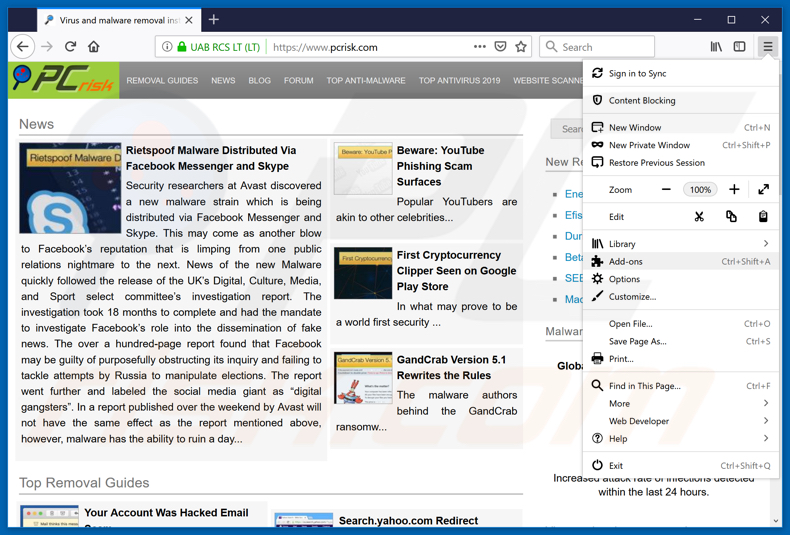
Click the Firefox menu ![]() (at the top right corner of the main window), select "Add-ons". Click on "Extensions", in the opened window, remove all recently-installed suspicious browser plug-ins.
(at the top right corner of the main window), select "Add-ons". Click on "Extensions", in the opened window, remove all recently-installed suspicious browser plug-ins.
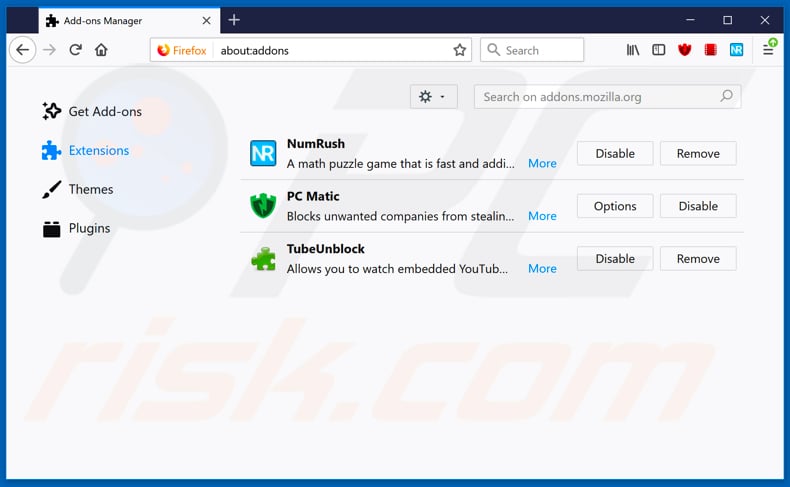
Optional method:
Computer users who have problems with "chrome update center" pop-up removal can reset their Mozilla Firefox settings.
Open Mozilla Firefox, at the top right corner of the main window, click the Firefox menu, ![]() in the opened menu, click Help.
in the opened menu, click Help.

Select Troubleshooting Information.

In the opened window, click the Refresh Firefox button.

In the opened window, confirm that you wish to reset Mozilla Firefox settings to default by clicking the Refresh Firefox button.

 Remove malicious extensions from Safari:
Remove malicious extensions from Safari:

Make sure your Safari browser is active, click Safari menu, and select Preferences....

In the opened window click Extensions, locate any recently installed suspicious extension, select it and click Uninstall.
Optional method:
Make sure your Safari browser is active and click on Safari menu. From the drop down menu select Clear History and Website Data...

In the opened window select all history and click the Clear History button.

 Remove malicious extensions from Microsoft Edge:
Remove malicious extensions from Microsoft Edge:

Click the Edge menu icon ![]() (at the upper-right corner of Microsoft Edge), select "Extensions". Locate all recently-installed suspicious browser add-ons and click "Remove" below their names.
(at the upper-right corner of Microsoft Edge), select "Extensions". Locate all recently-installed suspicious browser add-ons and click "Remove" below their names.

Optional method:
If you continue to have problems with removal of the "chrome update center" pop-up, reset your Microsoft Edge browser settings. Click the Edge menu icon ![]() (at the top right corner of Microsoft Edge) and select Settings.
(at the top right corner of Microsoft Edge) and select Settings.

In the opened settings menu select Reset settings.

Select Restore settings to their default values. In the opened window, confirm that you wish to reset Microsoft Edge settings to default by clicking the Reset button.

- If this did not help, follow these alternative instructions explaining how to reset the Microsoft Edge browser.
Share:

Tomas Meskauskas
Expert security researcher, professional malware analyst
I am passionate about computer security and technology. I have an experience of over 10 years working in various companies related to computer technical issue solving and Internet security. I have been working as an author and editor for pcrisk.com since 2010. Follow me on Twitter and LinkedIn to stay informed about the latest online security threats.
PCrisk security portal is brought by a company RCS LT.
Joined forces of security researchers help educate computer users about the latest online security threats. More information about the company RCS LT.
Our malware removal guides are free. However, if you want to support us you can send us a donation.
DonatePCrisk security portal is brought by a company RCS LT.
Joined forces of security researchers help educate computer users about the latest online security threats. More information about the company RCS LT.
Our malware removal guides are free. However, if you want to support us you can send us a donation.
Donate
▼ Show Discussion